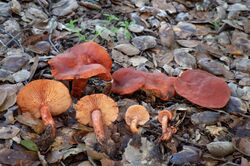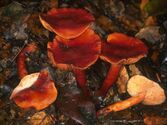Biology:Lactarius rufulus
| Lactarius rufulus | |
|---|---|

| |
| Scientific classification | |
| Domain: | Eukaryota |
| Kingdom: | Fungi |
| Division: | Basidiomycota |
| Class: | Agaricomycetes |
| Order: | Russulales |
| Family: | Russulaceae |
| Genus: | Lactarius |
| Species: | L. rufulus
|
| Binomial name | |
| Lactarius rufulus Peck (1907)
| |
| Lactarius rufulus | |
|---|---|
| Mycological characteristics | |
| gills on hymenium | |
| cap is depressed | |
| hymenium is decurrent | |
| stipe is bare | |
| spore print is cream to yellow | |
| ecology is mycorrhizal | |
| edibility: edible | |
Lactarius rufulus, commonly known as the rufous candy cap, is a species of fungus in the family Russulaceae. The fruit bodies have fleshy brownish-red caps up to 10 cm (3.9 in) wide, and closely spaced pinkish-yellow gills. The stem is up to 12 cm (4.7 in) long and 3 cm (1.2 in) thick and colored similarly to the cap. The species, known only from California , Arizona, and Mexico, grows on the ground in leaf litter near oak trees. The fruit bodies resembles those of L. rufus, but L. rufulus tends to grow in clusters at a common base, rather than solitarily or in groups. A distinguishing microscopic characteristic is the near absence of large, spherical cells called sphaerocysts that are otherwise common in Lactarius species. Lactarius rufulus mushrooms are edible, and have an odor resembling maple syrup. They have been used to flavor confections and desserts.
Taxonomy
The species was first described by American mycologist Charles Horton Peck in 1907, based on specimens collected at Stanford University in California.[1] The type collections were made by A.M. Patterson and S. Nohara, botany students at the Leland Stanford Junior University who made a number of collections during the winter of 1906–07.[2]
Lactarius rufulus is classified in the section Thejogali of the subgenus Russularia of the genus Lactarius. The surface characteristics of many species in section Thejogali (as defined by Hesler and Smith in 1979) are called rimulose-areolate (irregularly cracked, with the cracks crossing one another) based on a surface with "numerous mounds of inflated cells" paired together with crevices.[3]
The mushroom is commonly known as the "rufous candy cap".[4]
Description
The cap of L. rufulus is 3–10 cm (1.2–3.9 in) wide, broadly convex, becoming flattened and eventually shallowly funnel-shaped, sometimes with a slight umbo. The cap margin (edge) is initially curved inwards but becomes curved upward in maturity. The surface is usually uneven or wrinkled.[4] It is brownish red at first, but fades to orange-brown with age. The attachment of the gills to the stem is adnate (squarely attached) to subdecurrent (running slightly down the length of the stem). They are packed close together, at first pinkish-yellow, but with age become a darker red or reddish brown. The gills are not forked, nor do they stain a different color when bruised. The stem is 4–8 cm (1.6–3.1 in) long, about 0.5–1.5 cm (0.2–0.6 in) thick, nearly equal or slightly enlarged downward, dry, smooth, and reddish brown.[5][nb 1] It may be solid or stuffed (filled with cotton-like mycelia), but may become partially hollow with age. The flesh is firm, white to pinkish-orange, and does not stain when cut. The latex is scant, white, unchanging, and does not stain tissues. Its taste is mild. The spore print is white to creamy yellow.
The mushroom is edible,[6] with a mild taste and a slight odor of maple syrup.[nb 2] American author David Arora suggests that the fruit bodies may be used in a manner similar to the candy cap mushrooms, despite being not as fragrant.[7] Chefs in the San Francisco Bay Area have been known to use it for desserts such as ice creams, cakes and caramels.[8]
Microscopic characteristics
The spores are 7–9 by 7–9 µm, spherical or nearly so, ornamented with a partial to complete reticulum (a system of raised, net-like ridges), with prominences up to 0.5 µm high. The basidia (spore-bearing cells) are both two- and four-spored, and measure 45–52 by 9–11 µm. The cap cuticle is a poorly formed layer of inflated cells with scattered filamentous pileocystidia (cystidia on the cap).[6] Somewhat unusual for a Lactarius, L. rufulus lacks or has few swollen cells (sphaerocysts) in the cap and stem.[4]
Similar species
Lactarius rubidus is similar in appearance to L. rufulus, but it has watery to whey-like latex and develops a strong odor of maple syrup or butterscotch when dried. Another lookalike is Lactarius thiersii, but it has a smaller cap and stem and has mild-tasting flesh and latex. The flesh and latex of Lactarius rufus have a strongly acrid taste, and its fruit bodies are stouter and lack an umbo.[6] Additionally, L. rufus typically grows in a caespitose manner—with the fruit bodies clustered at a common base,[1] and has more pallid colors and a more intense odor than L. rufulus.[9] L. vinaceorufescens has a yellowing latex.[4]
Ecology, habitat and distribution
Lactarius rufulus is a mycorrhizal species, and lives in a mutualistic association with oak species. The fungus forms an ectomycorrhizae—characterized by an external sheath that surround the rootlets of the oak. The fungus receives soluble carbohydrates that are byproducts of the plant's photosynthesis, while affording the plant greater access to soil nutrients needed for growth. The fruit bodies of L. rufulus grow scattered or in groups on the ground under oak, usually from January to March; their appearance is uncommon.[6] Once thought to be only in California (where they are most prevalent in the southern part of the state),[4] they were reported from Mexico in 1998,[10] and from Arizona in 2006.[11]
See also
Notes
References
- ↑ 1.0 1.1 1.2 Peck CH. (1907). "New species of fungi". Bulletin of the Torrey Botanical Club 34 (7): 345–49. doi:10.2307/2478989.
- ↑ Kerrigan RW. (1979). "Studies in Agaricus I. Agaricus Pattersonae". Mycologia 71 (3): 612–20. doi:10.2307/3759070.
- ↑ Hesler and Smith, 1979, p. 25.
- ↑ 4.0 4.1 4.2 4.3 4.4 4.5 Arora D. (1986). Mushrooms Demystified: a Comprehensive Guide to the Fleshy Fungi. Berkeley, CA: Ten Speed Press. p. 23. ISBN 0-89815-169-4. https://books.google.com/books?id=87ct90d4B9gC&q=Lactarius%20rufulus&pg=PA23. Retrieved 2010-07-12.
- ↑ 5.0 5.1 Hesler and Smith, 1979, pp. 512–13.
- ↑ 6.0 6.1 6.2 6.3 Milk Mushrooms of North America: A Field Guide to the Genus Lactarius. Syracuse: Syracuse University Press. 2009. p. 235. ISBN 978-0-8156-3229-0.
- ↑ Arora D. (1991). All that the Rain Promises and More: a Hip Pocket Guide to Western Mushrooms. Berkeley, CA: Ten Speed Press. p. 23. ISBN 0-89815-388-3. https://books.google.com/books?id=87ct90d4B9gC&q=Lactarius%20rufulus&pg=PA23. Retrieved 2010-07-11.
- ↑ Alburger C. "Three's a Trend: Mushroom Desserts - San Francisco Restaurants and Dining - SFoodie". SFoodie. SF Weekly. http://blogs.sfweekly.com/foodie/2010/02/threes_a_trend_candy_cap_mushr.php.
- ↑ Viess D. "Lactarius rubidus and Lactarius rufulus, the "Candy Cap"". Bay Area Mycological Society. http://www.bayareamushrooms.org/mushroommonth/candy_cap.html.
- ↑ "Studies on Lactarius from Mexico: first report of Lactarius rufulus". Documents Mycologiques 28 (109–10): 29–32. 1998.
- ↑ Bates ST. (2006). "A preliminary checklist of Arizona macrofungi". Canotia 2 (2): 47–78. http://www.canotia.org/volumes/CANOTIA_2006_Vol2_2_Bates.pdf. Retrieved 2010-07-12.
Cited text
- North American Species of Lactarius. Michigan: The University of Michigan Press. 1979. ISBN 0-472-08440-2.
External links
- Lactarius rufulus in Index Fungorum
- Mushroom Observer Images
Wikidata ☰ Q3283832 entry
 |




